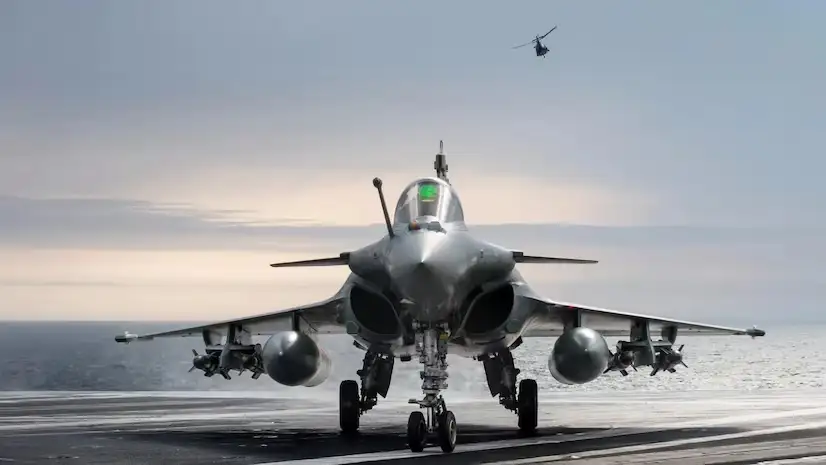India, France Lock Rs 63,000 Crore Deal For 26 Rafale-M Jets – How Will It Benefit the Indian Navy?
India and France have signed a landmark defense agreement worth approximately Rs 63,000 crore, securing the purchase of 26 Rafale-M fighter jets. This deal is a major step forward in strengthening India’s naval capabilities and enhancing its defense posture in the Indian Ocean Region (IOR). The signing ceremony, which took place with Defence Secretary Rajesh Kumar Singh and French Ambassador Thierry Mathou, marks a new chapter in the strategic partnership between the two nations.

Details of the Deal
The agreement will provide the Indian Navy with 26 Rafale-M (Marine) jets, specially designed for operations from aircraft carriers. This aircraft is a naval version of the Rafale fighter jet, which the Indian Air Force has successfully operated since 2020. The Rafale-M jets will enhance the Indian Navy’s ability to conduct air operations, giving it a greater edge over adversaries in the region.
Why Choose Rafale-M Jets?
The Rafale-M jets offer advanced capabilities, including air-to-air and air-to-ground strikes, long-range precision targeting, and electronic warfare systems. These fighter jets are ideal for operation on aircraft carriers, making them a crucial asset for India’s maritime defense strategy.
India faces growing security challenges in the Indian Ocean Region, with increasing naval activity from global powers. The Rafale-M jets will provide the Indian Navy with enhanced air superiority and the ability to project power far from its shores. Their versatility will enable the Navy to undertake a wide range of missions, including anti-aircraft operations, surveillance, and reconnaissance.
Strategic Benefits for the Indian Navy
The acquisition of these advanced fighter jets will provide the Indian Navy with several key strategic benefits:
- Enhanced Air Power at Sea: Rafale-M jets will boost the Navy’s air capabilities, allowing it to maintain control over maritime territories. The jets will conduct critical missions like anti-aircraft operations and precision strikes, ensuring India’s dominance over the seas.
- Operational Flexibility: The Rafale-M jets will offer greater flexibility for the Navy to respond swiftly to emerging threats in the region. Their quick deployment will ensure that the Navy can protect India’s interests, especially in vital sea lanes.
- Modernization of Fleet: The deal plays a crucial role in the Navy’s modernization efforts. The Rafale-M jets will significantly improve the Navy’s combat readiness, making it a stronger and more capable force.
- Technology Transfer and Indigenization: The agreement will facilitate technology transfer from France, enhancing India’s defense manufacturing capabilities. The deal will also help integrate cutting-edge French military technology into India’s defense ecosystem.
- Strengthening Bilateral Relations: This defense agreement deepens the strategic ties between India and France. Both nations share mutual interests in ensuring peace and stability in the Indo-Pacific, and this deal reflects their commitment to security cooperation.
India’s Long-Term Maritime Strategy
This deal is part of India’s broader maritime strategy to strengthen its naval capabilities in the face of rising regional tensions. The Indian Ocean is a crucial area for global trade, and securing these sea lanes is vital for both India and the international community. With the Rafale-M jets, the Indian Navy will be better equipped to secure its maritime borders and assert its presence in the region.
As China continues to expand its naval presence in the Indo-Pacific, India’s need for advanced defense systems becomes even more pressing. The Rafale-M jets will give India the power to challenge any adversary seeking to undermine its strategic interests in the region.
Challenges and Considerations
While this deal strengthens the Indian Navy, it also presents certain challenges. Integrating the Rafale-M jets into the Navy’s fleet and ensuring their readiness for operation will require time, training, and significant investment. Additionally, maintaining these sophisticated jets demands a robust infrastructure, both in India and through cooperation with France.
In the long term, India’s goal should be to develop more indigenous defense technologies. While this deal provides an immediate boost, India must continue to focus on creating a self-reliant defense ecosystem.
Conclusion
The Rs 63,000 crore deal for 26 Rafale-M fighter jets represents a major milestone in India’s defense modernization journey. By acquiring these advanced jets, the Indian Navy will gain enhanced air power, operational flexibility, and a greater ability to defend India’s maritime interests. As India strengthens its position in the Indian Ocean and beyond, the Rafale-M jets will serve as a key tool in ensuring its security and dominance in the region.
This deal also reinforces the growing defense ties between India and France, paving the way for deeper cooperation on security issues. The acquisition of the Rafale-M jets is not only a step forward for India’s naval capabilities but also for the country’s broader defense strategy.






